 KISS ME DEADLY
KISS ME DEADLYInfinity Minus One
Alessandro Mercuri __ January 05, 2014
<> PDF
“You’re a dreamer Lex Luthor, a sick twisted dreamer.”
Superman
Once upon a time, eons ago, towards the end of the 70s, in a distant galaxy, a father and his son lived upon a snowy planet named Krypton, a meringue of ice, frost and crystal. Jor-El was the father and Kal-El the newborn son. Their days were numbered. The sun of Krypton was about to perish. The explosion of the star was inevitable. The snowball planet was going to melt like a baked Alaska. To save his son, Jor-El placed the baby in a star-shaped crystal cradle.
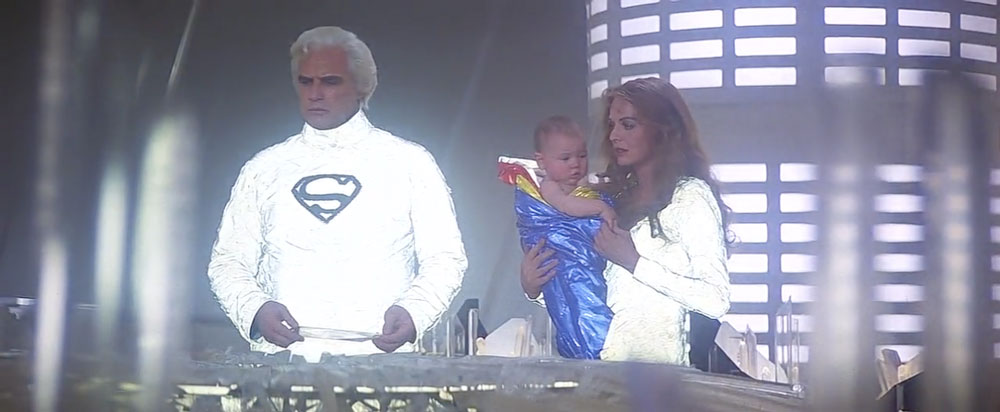
Superman (1978), directed by Richard Donner
“You’ll carry me inside you all the days of your life, you’ll make my strength your own, see my life through your eyes as your life will be seen through mine... The son shall become the father and the father...the son” says Jor-El to his son, tells Marlon Brando to the audience. Violins, igloos and paternal sobbing start up. Looking straight at the camera through the eyes of his son, Jor-El is Marlon Brando and Marlon Brando plays Superman’s father. Der Vater des Übermenschen. If God made man to his own image, then Marlon Brando made Superman to his own: “The son shall become the father and the father...the son.”
The crew on the movie set is amazed. On Krypton, Jor-El speaks from the heart, but in the immense 007 set of the Pinewood Studios, Marlon Brando refuses to learn his role or to know his dialogues by heart. He only reads from cards. But already, the star is engulfing Krypton.
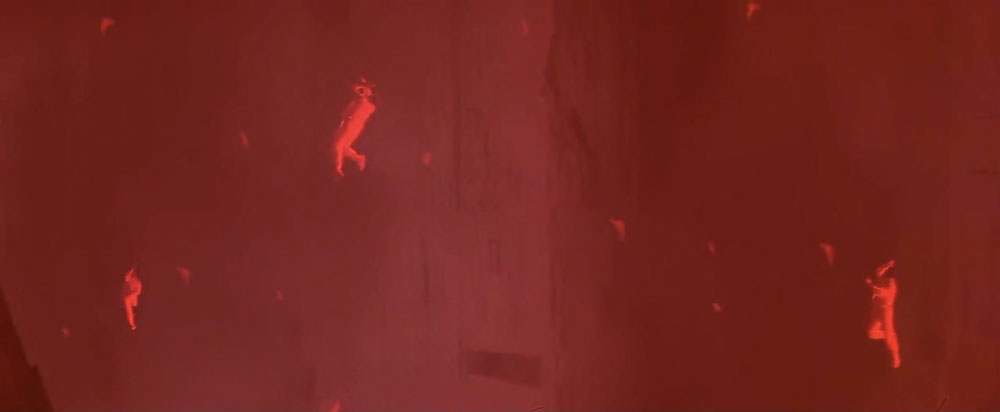
Superman (1978)
Opalescent stalactites break up amid frightening noise, the icebergs capsize, the inhabitants fall into terrible and cold abysses, glass roofs crash in, razor blades fall from the sharp glaciers, necks are cut, polar ice packs slide onto lava flows, polystyrene chunks float on blocks of red gelatin. Marlon Brando disappears into the collapse of a civilization, the explosion of a planet swallowed by its star.
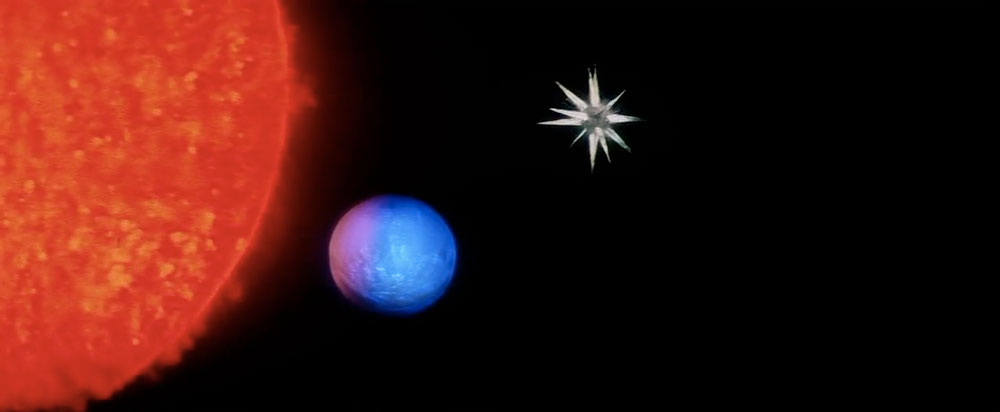
Superman (1978)
Once the apocalypse was over, the actor left the English studios of Buckinghamshire to go back to Tetiaroa, an atoll of pink coral and blue lagoons. Perfectly Polynesiac, rising up out of the sea north of Tahiti, the transparent island was purchased by the actor in 1965. Marlon Brando discovered Tetiaroa when involved in the filming of Mutiny on the Bounty. Wearing a tiara of multicolored bird feathers, surrounded by Tahitians men and women hiding their chest under flowers, their hair braided with leaves, King Pomare the 1st welcomes the crew of the English ship. Two centuries later, the royal family of Pomare welcome the Hollywood production filmed in this natural setting, in the very place where an uprising of sailors burst aboard His Majesty’s Armed Vessel Bounty in 1789. Many rioters abandoned ship and sought refuge on the island of Tetiaroa. This is a true story, of the cinéma-spectacular-verité kind. The Technicolor is the color of flowers.
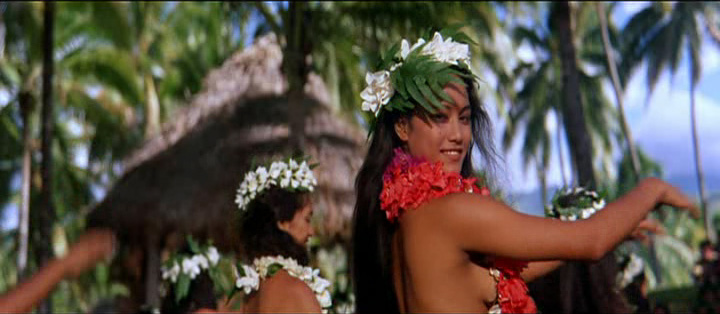
Mutiny on the Bounty (1962), directed by Lewis Milestone
The cinematic image is overwhelmed by amaryllis and black-spotted hibiscus, by tiaras and orchids. In the shade of blossoming palm trees, the first lieutenant Fletcher Christian embraces Maimiti, the indigenous goddess with necklaces of pearls and flowers. Marlon Brando embraces Tarita Teriipia, a Sino-Polynesian actress originally from Bora Bora. After the shooting of the film, the lovers get married. Ever since Marlon Brando has taken refuge each year upon the island.

Mutiny on the Bounty (1962)
Parrotfish, clownfish, squirrelfish and butterfly fish swim among the coral reef and the limestone peaks with their emerald, ruby and sapphire colors. In the clear waters of the lagoon, small jellyfish contract their umbrella in a cloud of tentacles and filaments. They are named Turritopsis nutricula. They are said to be immortal. An eternity filled with water, the transparent jellyfish whose heart has the shape of an oscillator has a reversible life cycle. They grow up, mature, evolve then grow young again and shrink in the course of the years, the centuries and the millennia. On the heavenly island, the tranquility is driven by a perpetual motion. Century-old giant turtles lay their eggs in the sand. Marlon Brando, stretched out in his hammock, savors shellfish of mother-of-pearl and flesh.
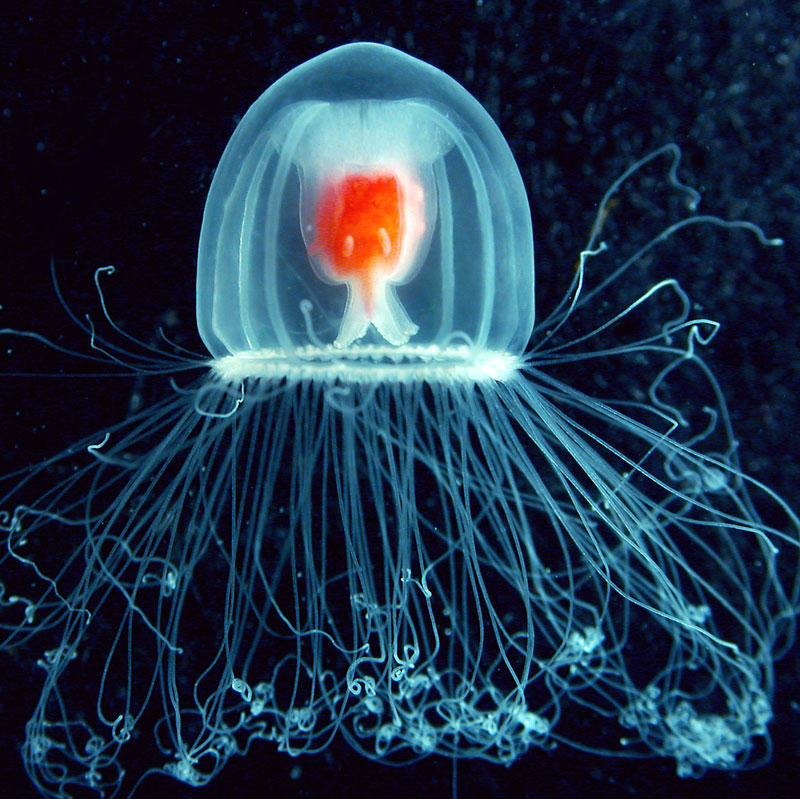
Méduse Turritopsis nutricula, photography by Peter Schuchert
In the early 1980s, on the island of Tetiaroa, the one who played in A Tramway named desire, Julius Caesar, Viva Zapata, Reflections in a Golden Eye, met the actor of Pizzaiolo et Mozzarel, Les Ringards, Plus beau que moi, tu meurs, and Te marre pas... c’est pour rire. Marlon Brando rented out his island for the filming of Bourreau des coeurs, a terribly French “French comedy” with Aldo Maccione. A wave of blokishness with sandy-smutty alluvions prolonged this actor’s influence in ultramarine France. Aldo Maccione asked Marlon Brando “Do you want a small part in the film?” “Are you kidding?” Brando replied. Let’s stop messing about. Back to super-heroes.
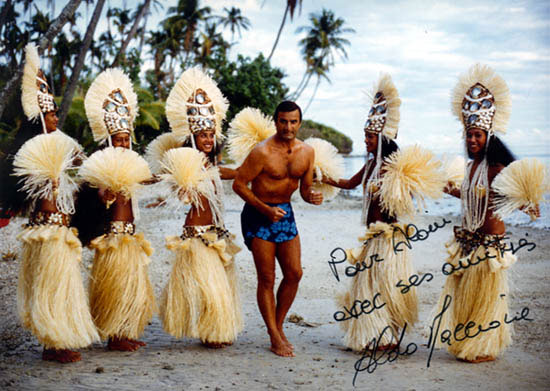
Le Bourreau des coeurs (1983), directed by Christian Gion
On the shore of Tetiaroa, the actor who played Jor-El, the father of Superman, gave an interview to the magazine Playboy, speaking of his experience as an actor, of his improvisation and of his reading of the cards on planet Krypton: “It is wonderful not having to learn your lines. You gain time and nobody can tell the difference. It makes you more spontaneous, because you really have no idea about what you’re going to do. You have a vague idea of what you’re going to say, you say it and then you cannot remember what you really wanted to say.” The aesthetic manifesto and the artistic performance have a price. Marlon Brando worked on set for 13 days and received a paycheck of almost 4 million dollars in 1978 – a rate of $8 per second. If we consider the financial clauses of his contract, his salary amounted to $30 per second. As both the Grand Master of France Jacques de La Palice and Andy Warhol once said, “Time is money” and “Art is money”.
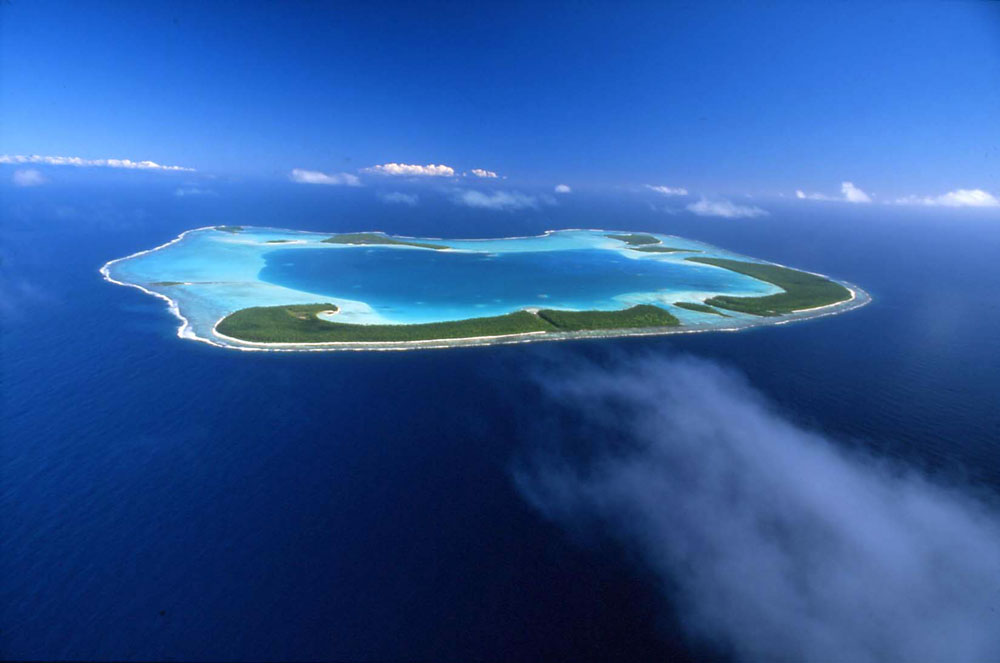
Tetiaroa island
Can we seriously imagine that Superman would have been Superman if his father had not been Marlon Brando? Could Superman have flown through the universe in his starry crystal cradle if he had not sprung from the cosmic semen of his extraordinary extraterrestrial father? As shown by the cinematographic legend, the interstellar journey of the young Kal-El ends when he lands on planet Earth and grows up on a farm in the Middle West. Once fully grown, he takes up the career of a superhero disguised in polyester prêt-à-porter; he then keeps on saving innocent mankind and more particularly the population of Metropolis.
Of course who could believe such a story? A Metropolis television channel questions the existence of the flying character and describes his improbable adventures as a “fantastic hoax”. Superman is not yet Superman. The Metropolis Post carries the headline: “It flies”, thus insisting on the anonymity of the figure and on the fact that he has no name. The Metropolis Times: “Blue Bomb buzzes Metropolis”. The Daily News writes: “Look Ma—No wires!” and the Daily Planet: “Caped Wonder Stuns City”.



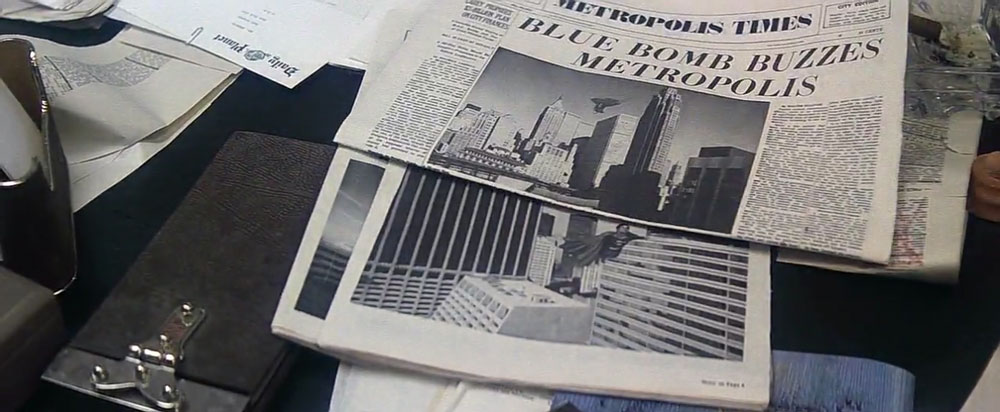
Superman (1978)
An imaginary New York or a fictitious Chicago, the city of Metropolis doubts the existence of the extraterrestrial superhero. The American metropolis of Superman may not exist, but there is in the state of Illinois a city of 15,561 inhabitants called Metropolis, founded well before the creation of the flying myth. The true Metropolis therefore considers itself naturally as the city of Superman, even as the “native city” where Kal-El grew up, a small fictitious city called Smallville. In Metropolis, everything bears the logo and the stamp of the superhero. There, the American flag resembles a magic red cape floating in the wind. The city also houses a Super Museum entirely devoted to Kal-El and to his many visual incarnations, comic books (since 1932), cartoons (since 1941), cinema adaptations (since 1948) and television adaptation (since 1950). In front of the courthouse of Metropolis, the capital of the county of Massac, is erected a huge bronze statue of the super avenger and upholder of the law painted in red (boots, cape and pants), blue (combination bodysuit and tights) and yellow (belt and famous background of the Supermanesque red S). From the heights of his gaze, five meters and two tons of myth look down on us. But the most extraordinary supermanesque element of Metropolis is without doubt its local journal: The Metropolis Planet.

Superman statue, Metropolis, Illinois, USA

Front page of the Metropolis Planet - weekly newspaper - April 13, 2011
On the cover the planetary title shines brightly and its globe, similar to the one found on the cover of the imaginary Daily Planet—the daily paper of the fictitious Metropolis—radiates light. Like Atlas supporting the earth, Superman stands guard upon the terrestrial ring of Metropolis. If the real journal of the true Metropolis has been inspired by the fictitious daily paper of the imaginary Metropolis, then how can we distinguish the true from the false, reality from fiction?
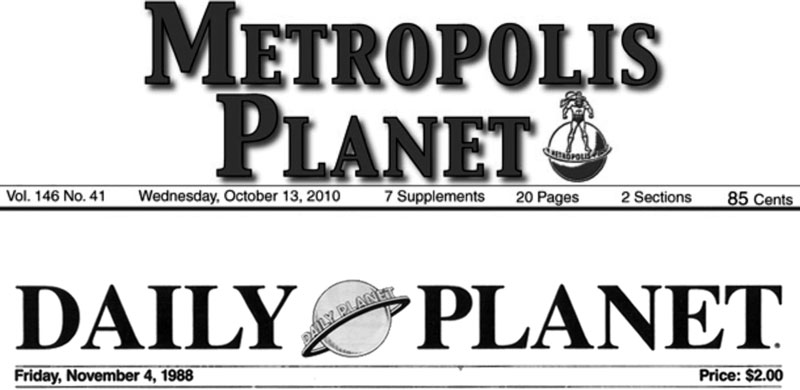
– (...) But you don’t mean to say that you seriously believe that Life imitates Art, that Life in fact is the mirror, and Art the reality?
– (...) Certainly I do. Paradox though it may seem—and paradoxes are always dangerous things—it is none the less true that Life imitates art far more than Art imitates life.
Thus spoke the characters of Oscar Wilde’s The Decay of Dying –An Observation, and the Metropolis Planet appear to be definitely more fictitious than the imaginary Daily Planet.
Journalism is a leitmotif throughout the adventures of Superman. As everyone knows, Clark Kent is the double of the yet-unnamed Superman. “Clark Kent” is a cover, an imposter, a fraud, who pretends to be what he is: a journalist. Clark Kent offers a journalistic legitimacy to the mythological tale of Superman. Journalism saves appearances and transforms the impossibility of the tale in factual reality. He is the hidden side of imaginary fiction; the spirit of comedy at the heart of the epic. In a fluttering of eyelids the polarities are reversed and Clark Kent becomes Superman. The transformation is as swift as lightening, skillful and insidious like a subliminal advert. But Superman remains “It”, a superhero without a name. The Kal-El / Clark Kent mutation must also occur through words. The character must tell his own tale. Fortunately, Clark Kent is a journalist of the Daily Planet. “Whichever one of you gets it out... is going to wind up with the single most important interview since... God talked to Moses!” shouts the chief editor of the daily.
As if to echo Jor-El / Marlon Brando’s confession in Playboy magazine, here are some excerpts from Lois Lane’s 1978 interview with Superman, published in the Daily Planet, founded in Metropolis in 1775:
- Would you like a glass of wine?
- No, no, thank you, never when I fly.
- Let’s start with your vital statistics. Are you married?
- Huh, no I’m not.
- Do you have a girlfriend?
- No, I don’t but if I did Miss Lane, you would be the first to know about it.
- How old are you?
- Over 21.
- How tall are you?
- About 6’4.
- And how much do you weigh?
- Oh, around 225.
- 225?
- Well I assume then that the rest of your bodily functions are normal?
- Sorry, I beg your pardon?
- Well, putting it delicately… do you… eat?
- Yes, yes I do when I’m hungry.
- You do, of course you do, well, then is it true that you can see through anything?
- Yes I can, pretty much.
- What color are the panties I’m wearing?... Oh, I’m sorry I embarrassed you, didn’t I?
- Oh, no, Miss Lane, it’s just…
- Pink.
- What…?
Their mouths are so close, their lips almost touching as if their eyes were murmuring:
- Your panties are pink…
- Do you like Pink?
- I like pink very much, Lois.
Lois is naked beneath the pink silk. Superman is sporting red pants over tight blue briefs which display with grace his male attributes. And Lois loses herself in endless fantasies of instantaneous orgasms and permanent voluptuousness.
- Why you?
- I’m sorry?
- I mean, “Why are you here?” There must be a reason for you to be here.
-Yes, I’m here to fight for truth and justice and the American Way.
Lois has irresistibly fallen under the charm of the Superhero, the queer Nietzschean superman, smooth-faced or shaven. Lois is suddenly linguistically inspired, beyond the ecstasies of the flesh.
- What a super man…
(Pause)
- Superman!
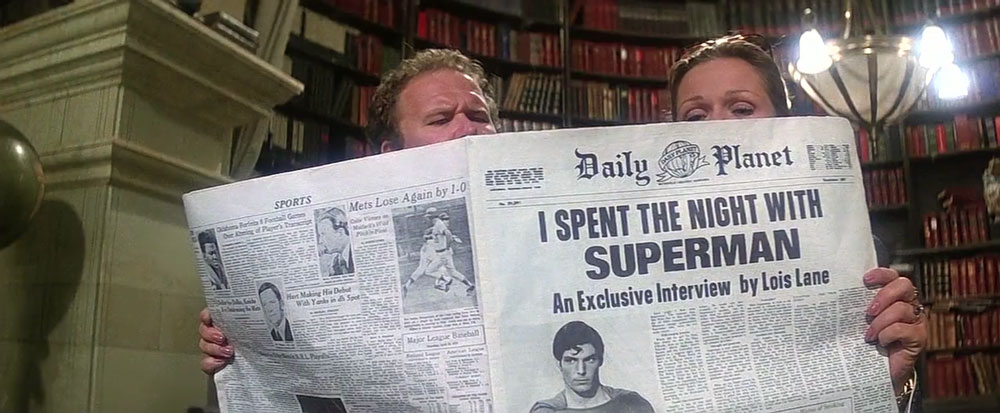
Superman (1978)
The next morning the front page headline of the Daily Planet reads: “I spent the night with Superman”. Karl-El, the human-like extraterrestrial creature, a.k.a. Clark Kent the earthly journalist, has been given a name by a woman and becomes Superman. But one question remains unanswered:
- How fast do you fly?
- Oh, I don’t know, I have never actually bothered to time myself.
The Metropolis television channels follow Superman’s exploits in real time, 24 hours a day, 7 days a week. The only surviving inhabitant of the planet Krypton seems endowed with the power of ubiquity. He can be here and there and now in no time. In his crystalline fortress of ice and solitude, Karl-El and the living and irradiating memory of Jor-El discuss the nature of time:
- According to my calculations, when you get this message, I will have been dead for thousands of your years… But still you must keep your secret identity.
- Why?
- The reasons are two. First, you cannot serve humanity 28 hours a day.
-24.
-Or 24, as it is in Earth time.
On Earth, day does not only follow night. From East to West, it is night and day at the same time. Dark and light, like summer and winter, are concomitant in both hemispheres. Such is the earthly contradiction. On Earth Kal-El is both Superman and Clark Kent. But on a day of great tragedy, Lois dies swallowed by the San Andreas Fault during an earthquake, the ground opening up, caving in and cracking. In a thundering roar, Superman screams out in sorrow and despair. He soars up toward the sky, through the clouds and the atmosphere to reach the stellar night. Like a rocket, the superhero takes off and frees himself of the Earth’s gravitation at the speed of 11 kilometers per second. Gravity is defeated. Lightness is the victor. This is how escape velocity is defined, known also under a number of different names such as escape speed or parabolic speed. According to the magic formula, v is the speed, G the gravitational constant of the universe, M the mass of the planet in kilograms, and R his radius in meters.
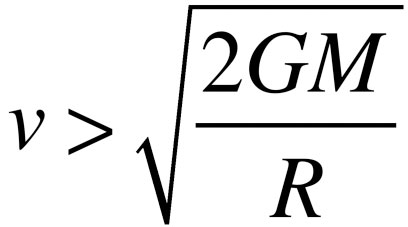
Is Superman on the verge of violating the laws of physics? Suddenly the voice of his father Jor-El resonates in orbit around the blue planet: “My son, it is forbidden for you to interfere with human history”. Has the Holy Spirit ever asked his son Jesus not to interfere with human history? Groaning with pain but possessing a divine power, Superman flies around the earth, in the opposite direction of its rotation, covering the distance of the equatorial circumference at the speed of 22 kilometers per second.
The Super-hero must rush because already the dead Lois is about to cross the river Styx. Superman is no Orpheus so he’d better hurry. Upset but determined, he accelerates to the final point where the earth slows down, stops and begins to spin backwards, rewinding the course of time. Always on time, Superman saves Lois even before the catastrophe has happened. The supersonic American hero has reached absolute speed, when the light goes through the void: 300,000 kilometers per second. Marlon Brando is dozing in his hammock and, as if in a dream, Jor-El exclaims at the start of the film:
“This is no fantasy, no careless product of a wild imagination”.
Translated from the French by Paul Stubbs & Blandine Longre
“You’re a dreamer Lex Luthor, a sick twisted dreamer.”
Superman
Once upon a time, eons ago, towards the end of the 70s, in a distant galaxy, a father and his son lived upon a snowy planet named Krypton, a meringue of ice, frost and crystal. Jor-El was the father and Kal-El the newborn son. Their days were numbered. The sun of Krypton was about to perish. The explosion of the star was inevitable. The snowball planet was going to melt like a baked Alaska. To save his son, Jor-El placed the baby in a star-shaped crystal cradle.

Superman (1978), directed by Richard Donner
“You’ll carry me inside you all the days of your life, you’ll make my strength your own, see my life through your eyes as your life will be seen through mine... The son shall become the father and the father...the son” says Jor-El to his son, tells Marlon Brando to the audience. Violins, igloos and paternal sobbing start up. Looking straight at the camera through the eyes of his son, Jor-El is Marlon Brando and Marlon Brando plays Superman’s father. Der Vater des Übermenschen. If God made man to his own image, then Marlon Brando made Superman to his own: “The son shall become the father and the father...the son.”
The crew on the movie set is amazed. On Krypton, Jor-El speaks from the heart, but in the immense 007 set of the Pinewood Studios, Marlon Brando refuses to learn his role or to know his dialogues by heart. He only reads from cards. But already, the star is engulfing Krypton.

Superman (1978)
Opalescent stalactites break up amid frightening noise, the icebergs capsize, the inhabitants fall into terrible and cold abysses, glass roofs crash in, razor blades fall from the sharp glaciers, necks are cut, polar ice packs slide onto lava flows, polystyrene chunks float on blocks of red gelatin. Marlon Brando disappears into the collapse of a civilization, the explosion of a planet swallowed by its star.

Superman (1978)
Once the apocalypse was over, the actor left the English studios of Buckinghamshire to go back to Tetiaroa, an atoll of pink coral and blue lagoons. Perfectly Polynesiac, rising up out of the sea north of Tahiti, the transparent island was purchased by the actor in 1965. Marlon Brando discovered Tetiaroa when involved in the filming of Mutiny on the Bounty. Wearing a tiara of multicolored bird feathers, surrounded by Tahitians men and women hiding their chest under flowers, their hair braided with leaves, King Pomare the 1st welcomes the crew of the English ship. Two centuries later, the royal family of Pomare welcome the Hollywood production filmed in this natural setting, in the very place where an uprising of sailors burst aboard His Majesty’s Armed Vessel Bounty in 1789. Many rioters abandoned ship and sought refuge on the island of Tetiaroa. This is a true story, of the cinéma-spectacular-verité kind. The Technicolor is the color of flowers.

Mutiny on the Bounty (1962), directed by Lewis Milestone
The cinematic image is overwhelmed by amaryllis and black-spotted hibiscus, by tiaras and orchids. In the shade of blossoming palm trees, the first lieutenant Fletcher Christian embraces Maimiti, the indigenous goddess with necklaces of pearls and flowers. Marlon Brando embraces Tarita Teriipia, a Sino-Polynesian actress originally from Bora Bora. After the shooting of the film, the lovers get married. Ever since Marlon Brando has taken refuge each year upon the island.

Mutiny on the Bounty (1962)
Parrotfish, clownfish, squirrelfish and butterfly fish swim among the coral reef and the limestone peaks with their emerald, ruby and sapphire colors. In the clear waters of the lagoon, small jellyfish contract their umbrella in a cloud of tentacles and filaments. They are named Turritopsis nutricula. They are said to be immortal. An eternity filled with water, the transparent jellyfish whose heart has the shape of an oscillator has a reversible life cycle. They grow up, mature, evolve then grow young again and shrink in the course of the years, the centuries and the millennia. On the heavenly island, the tranquility is driven by a perpetual motion. Century-old giant turtles lay their eggs in the sand. Marlon Brando, stretched out in his hammock, savors shellfish of mother-of-pearl and flesh.

Méduse Turritopsis nutricula, photography by Peter Schuchert
In the early 1980s, on the island of Tetiaroa, the one who played in A Tramway named desire, Julius Caesar, Viva Zapata, Reflections in a Golden Eye, met the actor of Pizzaiolo et Mozzarel, Les Ringards, Plus beau que moi, tu meurs, and Te marre pas... c’est pour rire. Marlon Brando rented out his island for the filming of Bourreau des coeurs, a terribly French “French comedy” with Aldo Maccione. A wave of blokishness with sandy-smutty alluvions prolonged this actor’s influence in ultramarine France. Aldo Maccione asked Marlon Brando “Do you want a small part in the film?” “Are you kidding?” Brando replied. Let’s stop messing about. Back to super-heroes.

Le Bourreau des coeurs (1983), directed by Christian Gion
On the shore of Tetiaroa, the actor who played Jor-El, the father of Superman, gave an interview to the magazine Playboy, speaking of his experience as an actor, of his improvisation and of his reading of the cards on planet Krypton: “It is wonderful not having to learn your lines. You gain time and nobody can tell the difference. It makes you more spontaneous, because you really have no idea about what you’re going to do. You have a vague idea of what you’re going to say, you say it and then you cannot remember what you really wanted to say.” The aesthetic manifesto and the artistic performance have a price. Marlon Brando worked on set for 13 days and received a paycheck of almost 4 million dollars in 1978 – a rate of $8 per second. If we consider the financial clauses of his contract, his salary amounted to $30 per second. As both the Grand Master of France Jacques de La Palice and Andy Warhol once said, “Time is money” and “Art is money”.

Tetiaroa island
Can we seriously imagine that Superman would have been Superman if his father had not been Marlon Brando? Could Superman have flown through the universe in his starry crystal cradle if he had not sprung from the cosmic semen of his extraordinary extraterrestrial father? As shown by the cinematographic legend, the interstellar journey of the young Kal-El ends when he lands on planet Earth and grows up on a farm in the Middle West. Once fully grown, he takes up the career of a superhero disguised in polyester prêt-à-porter; he then keeps on saving innocent mankind and more particularly the population of Metropolis.
Of course who could believe such a story? A Metropolis television channel questions the existence of the flying character and describes his improbable adventures as a “fantastic hoax”. Superman is not yet Superman. The Metropolis Post carries the headline: “It flies”, thus insisting on the anonymity of the figure and on the fact that he has no name. The Metropolis Times: “Blue Bomb buzzes Metropolis”. The Daily News writes: “Look Ma—No wires!” and the Daily Planet: “Caped Wonder Stuns City”.




Superman (1978)
An imaginary New York or a fictitious Chicago, the city of Metropolis doubts the existence of the extraterrestrial superhero. The American metropolis of Superman may not exist, but there is in the state of Illinois a city of 15,561 inhabitants called Metropolis, founded well before the creation of the flying myth. The true Metropolis therefore considers itself naturally as the city of Superman, even as the “native city” where Kal-El grew up, a small fictitious city called Smallville. In Metropolis, everything bears the logo and the stamp of the superhero. There, the American flag resembles a magic red cape floating in the wind. The city also houses a Super Museum entirely devoted to Kal-El and to his many visual incarnations, comic books (since 1932), cartoons (since 1941), cinema adaptations (since 1948) and television adaptation (since 1950). In front of the courthouse of Metropolis, the capital of the county of Massac, is erected a huge bronze statue of the super avenger and upholder of the law painted in red (boots, cape and pants), blue (combination bodysuit and tights) and yellow (belt and famous background of the Supermanesque red S). From the heights of his gaze, five meters and two tons of myth look down on us. But the most extraordinary supermanesque element of Metropolis is without doubt its local journal: The Metropolis Planet.

Superman statue, Metropolis, Illinois, USA

Front page of the Metropolis Planet - weekly newspaper - April 13, 2011
On the cover the planetary title shines brightly and its globe, similar to the one found on the cover of the imaginary Daily Planet—the daily paper of the fictitious Metropolis—radiates light. Like Atlas supporting the earth, Superman stands guard upon the terrestrial ring of Metropolis. If the real journal of the true Metropolis has been inspired by the fictitious daily paper of the imaginary Metropolis, then how can we distinguish the true from the false, reality from fiction?

– (...) But you don’t mean to say that you seriously believe that Life imitates Art, that Life in fact is the mirror, and Art the reality?
– (...) Certainly I do. Paradox though it may seem—and paradoxes are always dangerous things—it is none the less true that Life imitates art far more than Art imitates life.
Thus spoke the characters of Oscar Wilde’s The Decay of Dying –An Observation, and the Metropolis Planet appear to be definitely more fictitious than the imaginary Daily Planet.
Journalism is a leitmotif throughout the adventures of Superman. As everyone knows, Clark Kent is the double of the yet-unnamed Superman. “Clark Kent” is a cover, an imposter, a fraud, who pretends to be what he is: a journalist. Clark Kent offers a journalistic legitimacy to the mythological tale of Superman. Journalism saves appearances and transforms the impossibility of the tale in factual reality. He is the hidden side of imaginary fiction; the spirit of comedy at the heart of the epic. In a fluttering of eyelids the polarities are reversed and Clark Kent becomes Superman. The transformation is as swift as lightening, skillful and insidious like a subliminal advert. But Superman remains “It”, a superhero without a name. The Kal-El / Clark Kent mutation must also occur through words. The character must tell his own tale. Fortunately, Clark Kent is a journalist of the Daily Planet. “Whichever one of you gets it out... is going to wind up with the single most important interview since... God talked to Moses!” shouts the chief editor of the daily.
As if to echo Jor-El / Marlon Brando’s confession in Playboy magazine, here are some excerpts from Lois Lane’s 1978 interview with Superman, published in the Daily Planet, founded in Metropolis in 1775:
- Would you like a glass of wine?
- No, no, thank you, never when I fly.
- Let’s start with your vital statistics. Are you married?
- Huh, no I’m not.
- Do you have a girlfriend?
- No, I don’t but if I did Miss Lane, you would be the first to know about it.
- How old are you?
- Over 21.
- How tall are you?
- About 6’4.
- And how much do you weigh?
- Oh, around 225.
- 225?
- Well I assume then that the rest of your bodily functions are normal?
- Sorry, I beg your pardon?
- Well, putting it delicately… do you… eat?
- Yes, yes I do when I’m hungry.
- You do, of course you do, well, then is it true that you can see through anything?
- Yes I can, pretty much.
- What color are the panties I’m wearing?... Oh, I’m sorry I embarrassed you, didn’t I?
- Oh, no, Miss Lane, it’s just…
- Pink.
- What…?
Their mouths are so close, their lips almost touching as if their eyes were murmuring:
- Your panties are pink…
- Do you like Pink?
- I like pink very much, Lois.
Lois is naked beneath the pink silk. Superman is sporting red pants over tight blue briefs which display with grace his male attributes. And Lois loses herself in endless fantasies of instantaneous orgasms and permanent voluptuousness.
- Why you?
- I’m sorry?
- I mean, “Why are you here?” There must be a reason for you to be here.
-Yes, I’m here to fight for truth and justice and the American Way.
Lois has irresistibly fallen under the charm of the Superhero, the queer Nietzschean superman, smooth-faced or shaven. Lois is suddenly linguistically inspired, beyond the ecstasies of the flesh.
- What a super man…
(Pause)
- Superman!

Superman (1978)
The next morning the front page headline of the Daily Planet reads: “I spent the night with Superman”. Karl-El, the human-like extraterrestrial creature, a.k.a. Clark Kent the earthly journalist, has been given a name by a woman and becomes Superman. But one question remains unanswered:
- How fast do you fly?
- Oh, I don’t know, I have never actually bothered to time myself.
The Metropolis television channels follow Superman’s exploits in real time, 24 hours a day, 7 days a week. The only surviving inhabitant of the planet Krypton seems endowed with the power of ubiquity. He can be here and there and now in no time. In his crystalline fortress of ice and solitude, Karl-El and the living and irradiating memory of Jor-El discuss the nature of time:
- According to my calculations, when you get this message, I will have been dead for thousands of your years… But still you must keep your secret identity.
- Why?
- The reasons are two. First, you cannot serve humanity 28 hours a day.
-24.
-Or 24, as it is in Earth time.
On Earth, day does not only follow night. From East to West, it is night and day at the same time. Dark and light, like summer and winter, are concomitant in both hemispheres. Such is the earthly contradiction. On Earth Kal-El is both Superman and Clark Kent. But on a day of great tragedy, Lois dies swallowed by the San Andreas Fault during an earthquake, the ground opening up, caving in and cracking. In a thundering roar, Superman screams out in sorrow and despair. He soars up toward the sky, through the clouds and the atmosphere to reach the stellar night. Like a rocket, the superhero takes off and frees himself of the Earth’s gravitation at the speed of 11 kilometers per second. Gravity is defeated. Lightness is the victor. This is how escape velocity is defined, known also under a number of different names such as escape speed or parabolic speed. According to the magic formula, v is the speed, G the gravitational constant of the universe, M the mass of the planet in kilograms, and R his radius in meters.

Is Superman on the verge of violating the laws of physics? Suddenly the voice of his father Jor-El resonates in orbit around the blue planet: “My son, it is forbidden for you to interfere with human history”. Has the Holy Spirit ever asked his son Jesus not to interfere with human history? Groaning with pain but possessing a divine power, Superman flies around the earth, in the opposite direction of its rotation, covering the distance of the equatorial circumference at the speed of 22 kilometers per second.
The Super-hero must rush because already the dead Lois is about to cross the river Styx. Superman is no Orpheus so he’d better hurry. Upset but determined, he accelerates to the final point where the earth slows down, stops and begins to spin backwards, rewinding the course of time. Always on time, Superman saves Lois even before the catastrophe has happened. The supersonic American hero has reached absolute speed, when the light goes through the void: 300,000 kilometers per second. Marlon Brando is dozing in his hammock and, as if in a dream, Jor-El exclaims at the start of the film:
“This is no fantasy, no careless product of a wild imagination”.
Translated from the French by Paul Stubbs & Blandine Longre
TAGS : Infinity Minus One, Lex Luthor, Superman, Krypton. Jor-El, Kal-El, Richard Donner, Marlon Brando, studios Pinewood, Marlon Brando, Tetiaroa, Tahiti, Mutiny on the Bounty, King Pomare 1er, Tarita Teriipia, Turritopsis nutricula, Aldo Maccione, Playboy, Jacques de La Palice, Andy Warhol, prêt-à-porter polyester, Metropolis, Metropolis Post, Metropolis Times, Daily News, Daily Planet, Illinois, Smallville, Super Museum, Metropolis Planet, Oscar Wilde, The Decay of Dying – An Observation, Clark Kent, Loïs Lane, escape velocity, escape speed, parabolic speed, Styx, Orpheus
NEXT POST >>










